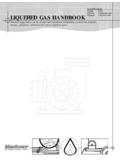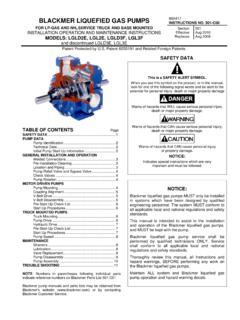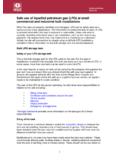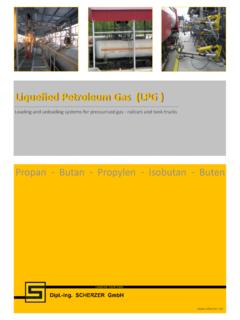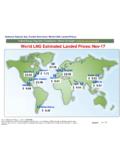Transcription of The Terrorist Threat to Liquefied Natural Gas: Fact …
1 The Terrorist Threat to Liquefied Natural Gas: Fact or Fiction? by LCDR Cindy Hurst February 2008 Institute for the Analysis of Global Security (IAGS) The Institute for the Analysis of Global Security (IAGS) is a Washington based non-profit public educational organization dedicated to research and public debate on issues related to energy security. IAGS seeks to promote public awareness to the strong impact energy has on the world economy and security and to the myriad of technological and policy solutions that could help nations strengthen their energy security.
2 Cindy Hurst is a political-military research analyst with the Foreign Military Studies Office. She is also a Lieutenant Commander in the United States Navy Reserve. The views expressed in this report are those of the author and do not necessarily represent the official policy or position of the Department of the Army, Department of Defense, or the Government. On 14 February 2007, the Saudi Arabian arm of al-Qaeda put out a call to all religious militants to attack oil and Natural gas sources around the world. Through such attacks, according to the call, al-Qaeda hopes to strangle the Such proclamations give fodder to those who highlight the possibilities that Liquefied Natural gas (LNG) could be used as a lethal weapon of mass destruction.
3 Industry officials on the other hand point out the improved security measures in place as a result of 9/11. While the continues to pursue LNG as a way to diversify its Natural gas resources in order to meet anticipated future shortfalls and increase energy security, opponents and proponents of LNG have been locked in a bitter debate with no solid conclusion. Proponents are correct in that both safety and security measures currently in place make LNG terminals and ships extremely hard targets for terrorists. However, it would be imprudent to believe that terrorists are either incapable or unwilling to attack such targets.
4 It would be equally imprudent to assume that these targets are impenetrable. If anything, in today s environment, insiders will always remain a potential Threat . Dangerous Assumptions On 1 February 2007, the media reported on a study by former White House counterterrorism chief Richard A. Clarke who worked as a consultant to a firm proposing an LNG terminal in eastern Baltimore County. Clarke is said to have released a two-page summary of his report on the proposed Sparrows Point LNG terminal in the Baltimore area. In it, he stated that the terminal would be located sufficiently far from homes and schools and would therefore pose no Threat .
5 Clarke, according to media reports, went on to justify his findings by saying that terrorists want to kill people. They want to kill hundreds of people. 2 Therefore, since the proposed terminal would be located to miles from the Dundalk neighborhood of Turners Station, according to Clarke, it would not be a sufficiently attractive target for terrorists. Additionally, he said that the facility would not be close enough to Washington to be a symbolic target. 3 However, recent studies run counter to Clarke s alleged conclusion. One of the best ways to study al-Qaeda, or any other Terrorist group, is through an analysis of historical trends.
6 In early 2007, Rand Corporation released a lengthy analytical report on Terrorist targeting preferences for the Department of Homeland Security. The paper focused on 14 Terrorist attacks in which al-Qaeda was believed to have been somehow involved, either through association, sponsorship or direction. According to the study, 10 out of the 14 attacks analyzed had either a medium or high casualty potential. In other words, these attacks were meant to kill people a lot of people. However, the other four attacks had a low casualty potential. The study further showed a desire to damage the economy, with 10 of the 14 attacks indicating a medium or high potential to damage the economy and the other four with a low Once ignited, as is very likely when the spill is initiated by a chemical explosion, the floating LNG pool will burn the attack on the World Trade Center in New York City, there exists no relevant industrial experience with fires of this scale from which to project measures for securing public safety.
7 Professor James Fay, Massachusetts Institute of Technology 4 potential. Based simply on the Rand study, Clarke s statement that the proposed terminal location would pose no Threat , is a dangerous assumption which leaves no room for error because al-Qaeda and its associates, through propagations distributed via the Internet, have already expressed an interest in crippling the economy. To further compound the argument against Clarke s conclusion, energy experts expect LNG imports into the to increase dramatically through 2030. This shift could potentially make LNG an even more desirable target as the becomes increasingly dependent on LNG to satisfy its growing Natural gas consumption habits.
8 The final argument against Clarke s claim, and perhaps the most compelling one, lies within a study released by the Government Accountability Office (GAO) in February 2007 on the public-safety consequences of a Terrorist attack on In its analysis, the GAO scrutinized six completed studies on the potential hazards of an LNG spill. The GAO then drew a series of conclusions from the studies and polled a panel of 19 experts to see whether or not they agreed with the findings. Not all experts agreed on the heat/hazard zone of an LNG spill. One quarter of the experts polled during the study believed that one to miles was not a sufficiently conservative estimate to describe the heat hazard zone of an LNG related fire.
9 If the experts who disagreed with this distance happen to be correct, it would put members of the general population located at the questionable threshold of or miles away from the site in a risky location. Probability and Motivation of a Terrorist Attack Few groups are capable of implementing an attack on LNG. However, an attack on LNG would fit well with al-Qaeda s tactics, techniques and procedures. al-Qaeda is a radical Sunni Muslim organization with approximately 50,000 members located at various bases of operations in 45 countries. In addition to its own members, al-Qaeda s network includes groups operating in up to 65 countries.
10 Al-Qaeda s objective is to serve as a defensive jihad fighting against anyone or anything it perceives as attacking Muslims across the world. As a result, the group s aim is to overthrow non-Islamic (or insufficiently Islamic) regimes that seem to oppress their Muslim citizens. In 32 incidents traced back to al-Qaeda, there were 3,464 deaths and 8,864 injuries. Although there has never been an attack against either an LNG terminal or tanker, maritime terrorism has been a core part of al-Qaeda and its affiliates historical strategy. In 2000, suicide bombers rammed the USS Cole in Yemen, killing 17 sailors.





